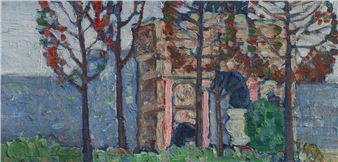In the Medium of Life: The Drawings of Beauford Delaney
For Beauford Delaney, drawing was both a sanctuary and a space for experimentation. Through his works on paper, he could explore ideas with intimacy and spontaneity, yet this vital area of his oeuvre has been largely overlooked. In the Medium of Life: The Drawings of Beauford Delaney marks New York's first major Delaney museum exhibition in over thirty years and the first ever focused on his drawings—a medium central to his artistic practice. The exhibition will feature about ninety works on paper spanning key periods of his career, as well as works on canvas and an array of ephemera—documentary photographs, correspondence, exhibition brochures, and press clippings—that contextualize his unique artistic trajectory.
Beauford Delaney holds a place in the history of American art of the postwar period that is challenging to define. Born in 1901 in Knoxville, Tennessee, he grew up in the segregated South and studied fine art at the Massachusetts Normal School in Boston in the late 1920s. By 1929, he had moved to New York, where he continued his artistic practice at the height of the Harlem Renaissance, producing realistic portraits and cubist-inflected street scenes of the Greenwich Village neighborhood where he lived. In 1953, at the urging of his friend, James Baldwin, Delaney moved to Paris, the city where he would spend the rest of his life. In Paris, Delaney drew and painted portraits, while at the same time, he developed an all-over calligraphic abstract painting style. For two decades, he painted abstract and figurative works simultaneously, sometimes combining both languages by inserting barely visible figures into abstract compositions, or by working up backgrounds full of abstract incidence that often competed with the fully realized portraits embedded within them. Delaney produced drawings from the beginning of his career in the early 1920s in Knoxville, until his mental illness prevented him from continuing in the early 1970s. Although he rarely drew preparatory sketches, his works on paper closely followed techniques and motifs he used in his paintings.

Recommended for you
For Beauford Delaney, drawing was both a sanctuary and a space for experimentation. Through his works on paper, he could explore ideas with intimacy and spontaneity, yet this vital area of his oeuvre has been largely overlooked. In the Medium of Life: The Drawings of Beauford Delaney marks New York's first major Delaney museum exhibition in over thirty years and the first ever focused on his drawings—a medium central to his artistic practice. The exhibition will feature about ninety works on paper spanning key periods of his career, as well as works on canvas and an array of ephemera—documentary photographs, correspondence, exhibition brochures, and press clippings—that contextualize his unique artistic trajectory.
Beauford Delaney holds a place in the history of American art of the postwar period that is challenging to define. Born in 1901 in Knoxville, Tennessee, he grew up in the segregated South and studied fine art at the Massachusetts Normal School in Boston in the late 1920s. By 1929, he had moved to New York, where he continued his artistic practice at the height of the Harlem Renaissance, producing realistic portraits and cubist-inflected street scenes of the Greenwich Village neighborhood where he lived. In 1953, at the urging of his friend, James Baldwin, Delaney moved to Paris, the city where he would spend the rest of his life. In Paris, Delaney drew and painted portraits, while at the same time, he developed an all-over calligraphic abstract painting style. For two decades, he painted abstract and figurative works simultaneously, sometimes combining both languages by inserting barely visible figures into abstract compositions, or by working up backgrounds full of abstract incidence that often competed with the fully realized portraits embedded within them. Delaney produced drawings from the beginning of his career in the early 1920s in Knoxville, until his mental illness prevented him from continuing in the early 1970s. Although he rarely drew preparatory sketches, his works on paper closely followed techniques and motifs he used in his paintings.
Artists on show
Contact details















